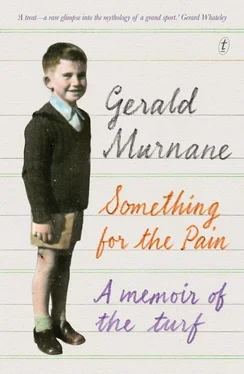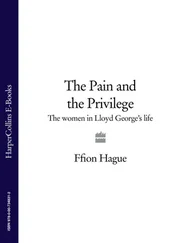And so, I followed Alf, as I’ll call him hence, to the rear of the ring, where I observed him put his thirty pounds, win-only, on a filly named Sandara (Red, black spots) at the odds of thirty-three-to-one. In fact, the bookmaker, following accepted custom, rounded off the bet. Alf stood to win a thousand pounds for his thirty pounds. I estimate the value of the outlay in today’s currency to have been at least fifteen hundred dollars and the value of the winnings, if the bet succeeded, to have been at least fifty thousand, and I still marvel at how bets of that size were considered modest indeed in 1956 and could be placed with no fuss with any of the lesser bookmakers at the rear of the ring.
I reported Alf’s bet to my father, and we consulted the race book in order to learn what possible connection existed between the outsider Sandara, which was trained at Flemington by a man named Burke, and Alf, who managed his stables at far-off Epsom, in Mordialloc. The connection was not hard to find. Sandara was to be ridden by Alan Yeomans, a leading jockey who had been (he may have been still — I don’t remember) apprenticed to Alf. Now, in those days, the Code of Racing, so to call it, had as its first commandment ‘Thou shalt not take the Stable’s market.’ The commandment acknowledged that the owner and trainer and stable followers of a horse with a good winning chance had first entitlement to the best of the odds bet about the horse. Any outsider happening to know of the horse’s ability and daring to alert the bookmakers with an early rush of money would reduce the odds available to the stable and would thereby commit racing’s worst crime. Sometimes a jockey would be in a position to commit this crime. He might be engaged to ride the horse although he was a freelance unconnected with the stable. In all my years as a follower of racing, I heard of only three instances of a jockey’s getting his own money on at top odds, being found out, and being afterwards punished. (Jockeys, of course, are prohibited from betting but who can police their betting through proxies?) Their punishment was severe indeed. Word of their crime was soon all over Melbourne, if not Victoria; their telephones stopped ringing; their careers were as good as over. My father and I understood at once why Alf was backing Sandara and why he was doing it on the outer edges of the ring. The jockey had passed on certain information to Alf, who could act on it but only with the utmost discretion. Alan Yeomans took Sandara to the lead soon after the start, and the filly was never in danger of being beaten. My father won a hundred pounds on the race with an outlay of only three.
I can report little else about the actual Alf Sands but much about the figure of that name who was one of the demigods in my private mythology of racing. I recall the afternoon when my father made a special trip to Caulfield after having heard from someone he trusted that the Sands stable was going to back one of several horses of theirs engaged that day. My father had no trouble identifying the horse when the time came. Pageoptic (some or another combination of yellow, green, and purple) had been performing only moderately for months past on provincial tracks, but was backed from sixteen-to-one into ten-to-one and won handsomely, and my father arrived home with his pockets bulging — metaphorically, if not literally.
One day in 1958, I read a newspaper report of a successful plunge at Werribee on a Sands-trained horse named Beau Conde (some or another combination of purple, yellow, and red). After the race, a woman had collected the winnings. She had gone from bookmaker to bookmaker, putting rolls of banknotes into a briefcase.
I have reported only three of Alf Sands’ many achievements, but these should be enough for my purposes. I have believed for most of my life in my private legend of Alf Sands, by which I mean that I have believed in a mythical man able to prevail against the odds. Sometimes his stable commissioners stride past one after another rails bookmaker, challenging each to risk the most he dares on a horse at long odds and with moderate form. At other times, the man himself lurks at the rear of the betting ring, looking to profit modestly from information obtained in the utmost secrecy. This man may have the appearance of the man that my father pointed out to me at Flemington in 1956, but much about him is other than factual. And so, A. R. Sands the demigod, as I call him, may have the sandy hair and the alert expression of the man that I followed through the betting ring, but whereas the man who backed Sandara had a wife and at least one child, my hero is unencumbered by domestic concerns. In his private life he resembles Jack Holt, a renowned trainer of the 1920s and 1930s, who became known as the Wizard of Mordialloc on account of his many successful betting coups. (It was a coincidence that both my hero-trainers had their stables at the same racecourse.) Holt was a lifelong bachelor who lived simply with his two unmarried sisters as housekeepers and companions. He had been born into poverty but amassed a fortune, most of which he bequeathed to charity.
Worshipping a demigod is rather like being in love — not the sort of love depicted in films or described in romance novels but the irrational, obsessive passion that has sometimes taken hold of me and that caused me to think for many years that I was unique, until I learned otherwise from reading the fiction of Marcel Proust. The worshipper of a demigod, far from approaching the object of worship, hangs back, keeps at a distance, remains for the time being unknown. For months, or even for years, it is enough for the worshipper to know that the demigod exists and is available for observation. During this period of preparation, the worshipper has to learn all that can possibly be learned about the demigod’s whims, preferences, beliefs, whatever comes under the heading of way of life . At the same time, the worshipper has to change, to improve, and to become worthy of the notice of the demigod at some fortunate time in the far future. Perhaps I exaggerate, but I can recall myself in late 1957 and early 1958 noting the details of every race start of every horse trained by Alf Sands. I had set myself the impossible task of learning from a longitudinal study of his horses’ careers how to predict when he was about to launch a betting plunge on one or another of them.
I recall a day in 1958 when I absented myself from the teachers’ college that I was obliged to attend daily. I travelled by bus to the Redan racecourse (Ballarat had two racecourses in those days — Dowling Forest and Redan). I was confident that one of the two Sands horses engaged that day would be well backed and would win. I even had the vague and absurd hope that one of the trusted stable punters, or even Alf himself, might see me collecting my modest winnings after the race and might be so impressed by my sagacity as to make himself known to me. (From this may be learned one of the several great differences between myself and my father, who were driven in opposite directions by our obsession with racing. He bet boldly and thrust himself into the company of the insiders, the smart men that he so admired; I bet timidly and dreamed about my admired characters from afar.) Nothing of the sort happened, and Alf’s horses finished well back after having drifted in the betting.
At the height of my infatuation with A. R. Sands and his ways, I noted that he had an entrant in the Melbourne Cup. This was in 1957, when I worked for a few months as a junior clerk, filling in time before I could begin my course at a primary teachers’ college. The man at the next desk was named Martin Dillon. He will be mentioned in another section of this book. He too was a racing tragic, although the expression had not yet been devised at that time. He had a great respect for Alf Sands but I could not persuade him that Alf’s horse was in the Cup with a genuine chance, as a racing journalist might have put it. Mr Dillon, as I called him (he was white-haired and sixtyish; I was eighteen) tried to explain to me that most owners of racehorses would be proud to have a horse good enough merely to compete in the Melbourne Cup and that the owners of Alf’s horse were surely no exception. The horse was named Carbea (its colours will be mentioned below); it had been running unplaced in recent country events; and its odds were a hundred-to-one. I did not claim that Carbea could win but I had convinced myself that it must have been much better than its form suggested if Alf Sands had approved of its being entered in the Cup. I bet Mr Dillon a pound (one-eighth of my weekly wage) that Carbea would finish in the first third of the field. In racing parlance, Carbea never flattered at any stage. He finished seventeenth of nineteen, and Mr Dillon said he had never earned a pound more easily.
Читать дальше












